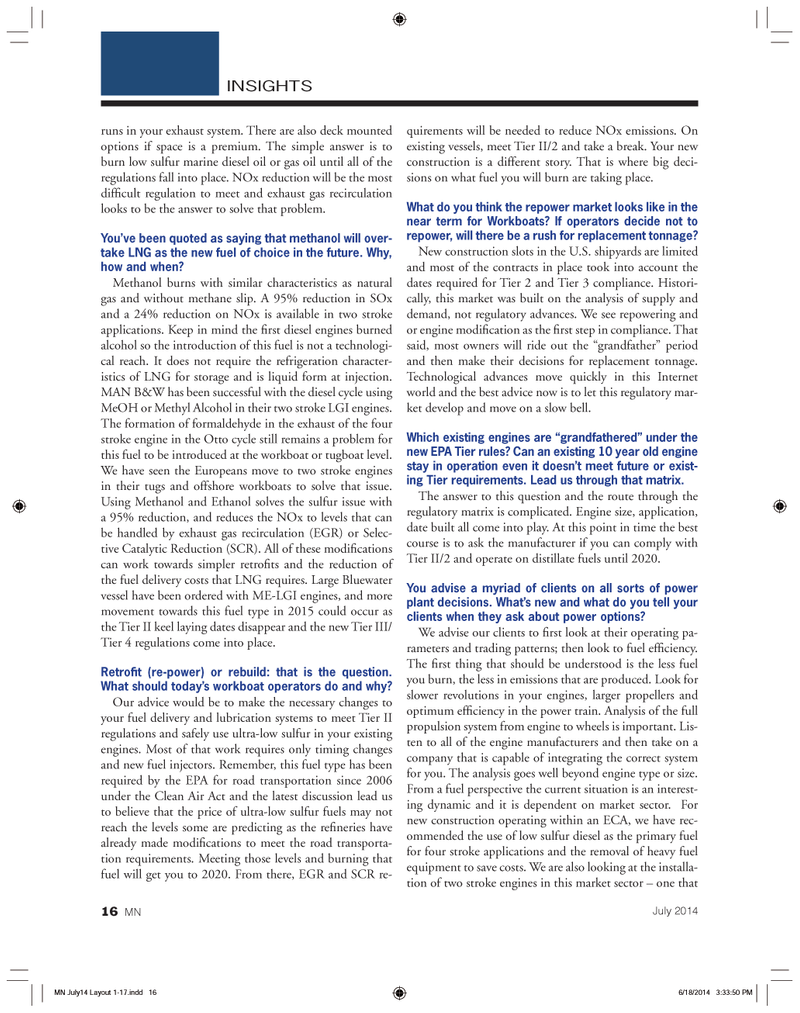
Page 16: of Marine News Magazine (July 2014)
ATB Technical Trends
Read this page in Pdf, Flash or Html5 edition of July 2014 Marine News Magazine
runs in your exhaust system. There are also deck mounted options if space is a premium. The simple answer is to burn low sulfur marine diesel oil or gas oil until all of the regulations fall into place. NOx reduction will be the most difÞ cult regulation to meet and exhaust gas recirculation looks to be the answer to solve that problem. You?ve been quoted as saying that methanol will over- take LNG as the new fuel of choice in the future. Why, how and when? Methanol burns with similar characteristics as natural gas and without methane slip. A 95% reduction in SOx and a 24% reduction on NOx is available in two stroke applications. Keep in mind the Þ rst diesel engines burned alcohol so the introduction of this fuel is not a technologi- cal reach. It does not require the refrigeration character- istics of LNG for storage and is liquid form at injection. MAN B&W has been successful with the diesel cycle using MeOH or Methyl Alcohol in their two stroke LGI engines. The formation of formaldehyde in the exhaust of the four stroke engine in the Otto cycle still remains a problem for this fuel to be introduced at the workboat or tugboat level. We have seen the Europeans move to two stroke engines in their tugs and offshore workboats to solve that issue. Using Methanol and Ethanol solves the sulfur issue with a 95% reduction, and reduces the NOx to levels that can be handled by exhaust gas recirculation (EGR) or Selec- tive Catalytic Reduction (SCR). All of these modiÞ cations can work towards simpler retroÞ ts and the reduction of the fuel delivery costs that LNG requires. Large Bluewater vessel have been ordered with ME-LGI engines, and more movement towards this fuel type in 2015 could occur as the Tier II keel laying dates disappear and the new Tier III/ Tier 4 regulations come into place. Retro t (re-power) or rebuild: that is the question. What should today?s workboat operators do and why? Our advice would be to make the necessary changes to your fuel delivery and lubrication systems to meet Tier II regulations and safely use ultra-low sulfur in your existing engines. Most of that work requires only timing changes and new fuel injectors. Remember, this fuel type has been required by the EPA for road transportation since 2006 under the Clean Air Act and the latest discussion lead us to believe that the price of ultra-low sulfur fuels may not reach the levels some are predicting as the reÞ neries have already made modiÞ cations to meet the road transporta- tion requirements. Meeting those levels and burning that fuel will get you to 2020. From there, EGR and SCR re- quirements will be needed to reduce NOx emissions. On existing vessels, meet Tier II/2 and take a break. Your new construction is a different story. That is where big deci- sions on what fuel you will burn are taking place. What do you think the repower market looks like in the near term for Workboats? If operators decide not to repower, will there be a rush for replacement tonnage? New construction slots in the U.S. shipyards are limited and most of the contracts in place took into account the dates required for Tier 2 and Tier 3 compliance. Histori- cally, this market was built on the analysis of supply and demand, not regulatory advances. We see repowering and or engine modiÞ cation as the Þ rst step in compliance. That said, most owners will ride out the ÒgrandfatherÓ period and then make their decisions for replacement tonnage. Technological advances move quickly in this Internet world and the best advice now is to let this regulatory mar- ket develop and move on a slow bell. Which existing engines are ?grandfathered? under the new EPA Tier rules? Can an existing 10 year old engine stay in operation even it doesn?t meet future or exist- ing Tier requirements. Lead us through that matrix. The answer to this question and the route through the regulatory matrix is complicated. Engine size, application, date built all come into play. At this point in time the best course is to ask the manufacturer if you can comply with Tier II/2 and operate on distillate fuels until 2020. You advise a myriad of clients on all sorts of power plant decisions. What?s new and what do you tell your clients when they ask about power options?We advise our clients to Þ rst look at their operating pa- rameters and trading patterns; then look to fuel efÞ ciency. The Þ rst thing that should be understood is the less fuel you burn, the less in emissions that are produced. Look for slower revolutions in your engines, larger propellers and optimum efÞ ciency in the power train. Analysis of the full propulsion system from engine to wheels is important. Lis- ten to all of the engine manufacturers and then take on a company that is capable of integrating the correct system for you. The analysis goes well beyond engine type or size. From a fuel perspective the current situation is an interest- ing dynamic and it is dependent on market sector. For new construction operating within an ECA, we have rec- ommended the use of low sulfur diesel as the primary fuel for four stroke applications and the removal of heavy fuel equipment to save costs. We are also looking at the installa- tion of two stroke engines in this market sector Ð one that INSIGHTSJuly 201416 MNMN July14 Layout 1-17.indd 16MN July14 Layout 1-17.indd 166/18/2014 3:33:50 PM6/18/2014 3:33:50 PM

 15
15

 17
17
